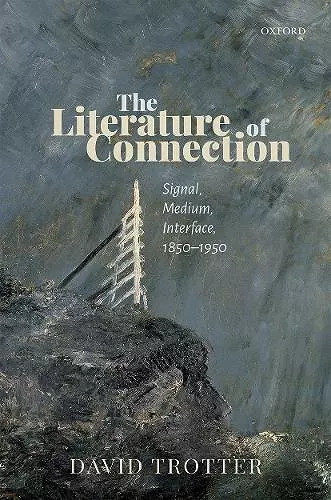The Literature of Connection
Signal, Medium, Interface, 1850-1950
Format:Hardback
Publisher:Oxford University Press
Published:11th Jun '20
Currently unavailable, and unfortunately no date known when it will be back

This book is about some of the ways in which the world got ready to be connected, long before the advent of the technologies and the concentrations of capital necessary to implement a global 'network society'. It investigates the prehistory not of the communications 'revolution' brought about by advances in electronic digital computing from 1950 onwards, but of the principle of connectivity which was to provide that revolution with its justification and rallying-cry. Connectivity's core principle is that what matters most in any act of telecommunication, and sometimes all that matters, is the fact of its having happened. During the nineteenth century, the principle gained steadily increasing traction by means not only of formal systems such as the telegraph, but of an array of improvised methods and signalling devices. These methods and devices fulfilled not just an ever more urgent need, but a fundamental recurring desire, for near-instantaneous real-time communication at a distance. Connectivity became an end in itself: a complex, vivid, unpredictable romance woven through the enduring human desire and need for remote intimacy. Its magical enhancements are the stuff of tragedy, comedy, satire, elegy, lyric, melodrama, and plain description; of literature, in short. The book develops the concepts of signal, medium, and interface to offer, in its first part, an alternative view of writing in Britain from George Eliot and Thomas Hardy to D.H. Lawrence, Hope Mirrlees, and Katherine Mansfield; and, in its second, case-studies of European and African-American fiction, and of interwar British cinema, designed to open the topic up for further enquiry.
[T]his is a fascinating examination of how we communicate with Trotter's humour and the chapters on signalling being the stand-out aspects of this work. * H-F Dessain, Bristish Association for Victorian Students *
Dazzling in its command of both history and literature, The Literature of Connection accomplishes its purpose, which, as Trotter writes in the conclusion, is "to demonstrate that the world was ready—indeed eager—to be connected long before the arrival of the technologies" needed to accomplish a "culture of connectivity" (p. 235). Symbols of restriction and freedom, from signal fires and semaphore on English coasts to airplanes conveying Black airmen, communicate through untold miles and through spaces measured only by human voices speaking face-to-face. * L. A. Brewer, CHOICE *
ISBN: 9780198850472
Dimensions: 241mm x 164mm x 24mm
Weight: 622g
304 pages